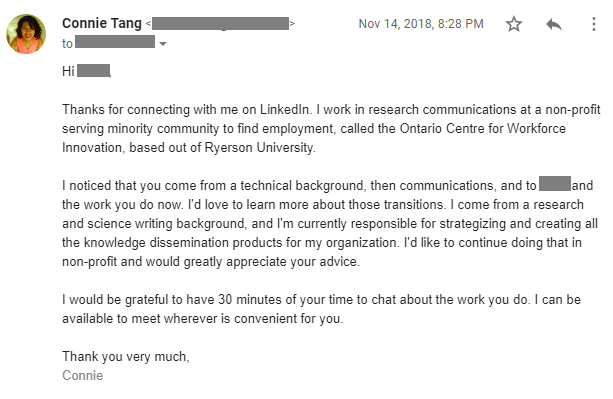This is Part II in a three-part blog series with practical tips for networking. Read Part I: Getting started and Part III: Following up.
Not to be dramatic (but also to be dramatic), networking is like soul searching. Both are an opportunity to learn about others and yourself. Both involve feeling awkward. It’s putting yourself out there and getting to know a stranger. If you feel awkward reaching out, you’re not alone.
Here are some things to keep in mind when reaching out to network.
- Introduce yourself briefly and then make the connection. Connection is something that relates you to the person you’re reaching out to. Perhaps you both went to grad school, had similar volunteer experience, have contact in common, or previously met at a panel or conference. The connection doesn’t have to be deep—one of my connections was that their organization was next door to my apartment.
- Put in a reason why you want to meet with this person and keep it short. Perhaps you want to make a similar career transition to them. Maybe they do work that you were inspired by or you’re interested in doing, too. Perhaps you want to work at a similar organization or even their organization. Any of these are great reasons.
- If possible, ask for 45 minutes for a coffee or video call. I found 45 minutes to be the sweet spot for the length of a chat. If the chat is awkward, it’s easy to pass 30 minutes of time before you cut it short and leave them an extra 15 minutes in their schedule. If the conversation is flowing, people will often have the extra 15 minutes to continue the conversation to the full hour.
- Reach out by email or LinkedIn. If you’re reaching out by email, then include your basic professional information in your email signature (i.e., position/degree, phone number, and link to your LinkedIn profile in your email signature).
- Lastly, if someone replies to you saying they would be happy to meet, ask them when and where. Minimize the back and forth in messages. If they provide a couple of dates and times in their reply and one works for you, then send the calendar invite directly to their email with either the in-person location or video calling link.
Here’s an example of an email I sent out:

Here are examples of LinkedIn messages I sent (same concept, just shorter messages). Pivot your connection with a reason for reaching out to this person to whatever fits best.
What do you talk about?
After I scheduled a chat with someone, my next question was: what do we talk about? If you search online, you can find lots of information on questions to ask during an informational interview. Listed below are some tips that I didn’t commonly see and worked best for me in practice.
- Make time for small talk. It’s easier to have a conversation when you start with some chit chat. The conversation flows better, and you can gauge their energy levels and get a feeling about how they answer questions. Ask about their weekend, talk about the weather, or ask about any recent vacations they took or a TV show they enjoyed recently.
- Ask personalized questions. You’ve done some research about this person, reviewed their LinkedIn profile, and read about their organization. Now’s the time to ask about the things you’re most curious about—and be thoughtful. For example, asking about a specific career transition they made is more effective than, “tell me about your career path”. It leads to more concrete responses and a better conversation. If their organization has a project that interests you, then ask how that project came about and what it entails.
- Evoke emotions. Following from the previous tip, try to make your questions evoke emotions. Instead of “What do you do day-to-day?”, you can ask:
-
- “What excites you about your work?”
- “What inspired you to pursue [thing]?”
- “What challenged you most when you worked as a [position]?”
- “What’s something you learned recently?”
- “What skill do you use the most in your job?”
-
With questions to evoke emotions, I found that I received responses that were more honest and informative. I found more to relate to in my own life, and it helped me learn what I was excited/inspired/challenged by for myself.
- Be vulnerable (with caveats). Often, you’re meeting a stranger, so you’re not going to expose all your deepest secrets to this person. But answering the question “tell me about yourself” shouldn’t sound like a scripted elevator pitch. During the strictest phases of quarantine, I found it helpful to be honest that I was struggling and had hit a wall with my motivation when I was introducing myself. There was no need to go into detail but being vulnerable set the stage to build a closer connection to the person I was speaking with, especially because the answer I received was usually, “I feel that too”.
- Questions to end with. I found there were a couple questions most useful to ask as you’re wrapping up the conversation (usually in the last 10–15 minutes):
-
- I also want to do [similar thing]. Do you have any advice for how I could get started?
- Is there anyone you would recommend I connect with?
- Can I follow up with you in 6 months if something relevant comes up?
-
Sending that first message to a stranger can make your heart race. That’s normal. Your heart will probably race again when you meet. Hopefully the awkwardness eases as the conversation flows. Remember: networking is a learning opportunity. So, high-five to you for messaging and meeting someone and embracing an opportunity to learn. But what happens now?





